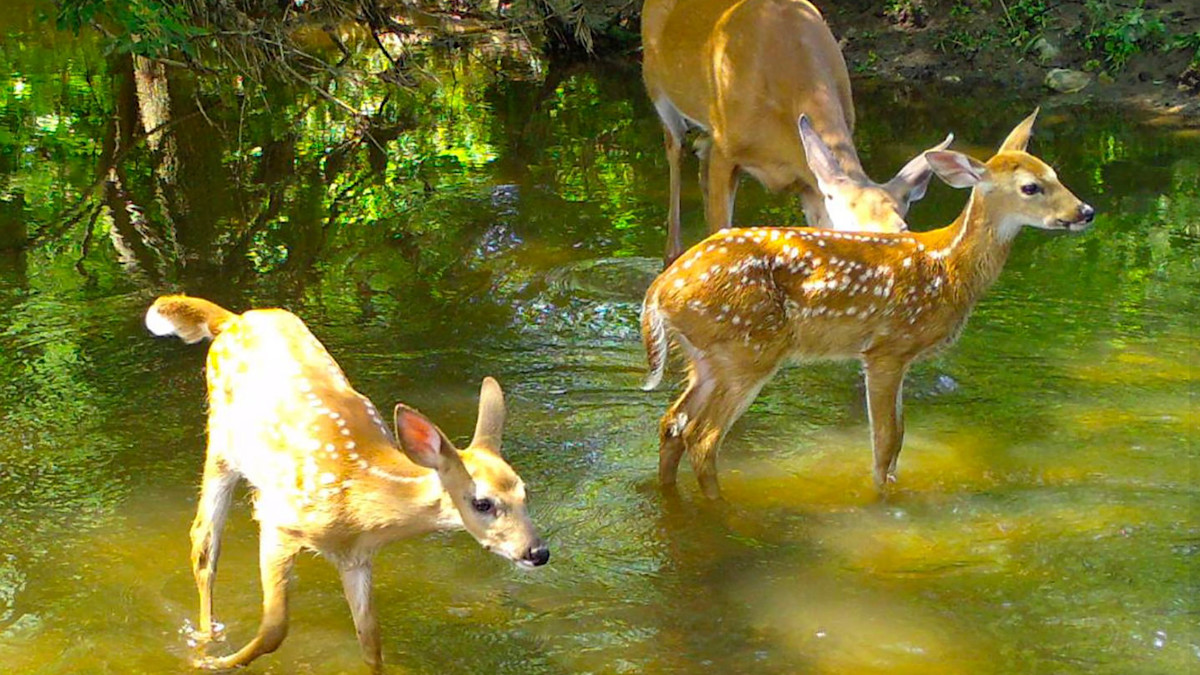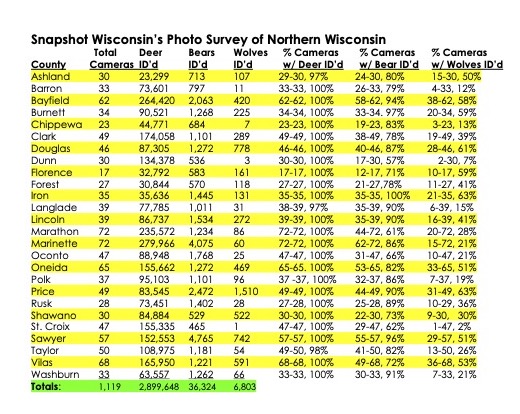
Wisconsinites who scorn gray wolves often claim they see far more of them than deer in the state’s northern forests over the past 20 years.
Those with trail cams—which are now as common as ravens and wood ticks in the Northwoods—often claim the same results, whether the cameras are monitoring bait piles, food plots, game trails, field edges, or two-track roads. All those photos from this 24-7 surveillance spawn endless posts and emails with surplus exclamation points:
“We seldom see deer on our trail cams anymore, but we see plenty of wolves!!!! Last fall before gun season I didn’t find five sets of deer tracks in the snow, but I found lots of wolf tracks!!!!! Wolf tracks in some spots on our logging road looked like cow paths!!!!!! That’s why there's no deer left in northern Wisconsin!!!!!!!”
But one trail cam and a Facebook rant don’t necessarily paint full pictures. In contrast, the “Snapshot Wisconsin Data Dashboard” offers broader perspectives. Snapshot Wisconsin is a popular citizen-science program that generates photo-driven data for the state’s Department of Natural Resources.
The program relies on students, individuals, and families to monitor trail cameras at assigned sites, and share everything with experts who identify and log what’s in the photos. Snapshot Wisconsin’s current data set covers January 2018 through December 2022.

2.9 Million Deer Photos
Data for the past five years raise questions about widespread claims that wolves rule Wisconsin’s Northwoods. For this review, we’ll define Wisconsin’s “Northwoods”—roughly its northern third—as the 26 counties north of an east-west line from Oconto County, bordering Green Bay, to St. Croix County, bordering Minnesota. From 2018 through 2022, Snapshot Wisconsin had 1,119 cameras in that region, and they snapped 2.9 million deer photos, 36,324 bear photos, and 6,803 wolf photos.
In other words, for each wolf photo, there were 5.3 bear photos and 426 deer photos. And for every bear photo, there were 80 deer photos. Further, not one of the 26 counties showed wolves, or even bears, anywhere close to equaling deer in Snapshot Wisconsin photos.
Note: Those totals aren’t population estimates or definitive statements about each species’ county-wide prevalence. After all, specific animals can appear in more than one photo. Also, deer and wolves roam the Northwoods year-round, while bears mostly hibernate from December through March.
Still, there’s no evidence that wolves are filling trailcam cards to capacity anywhere. Snapshot Wisconsin also identifies how many animals appear on each camera. Of those 1,119 cameras, only three failed to photograph a deer in those five years. That means 100% of the cameras in 23 counties snapped at least one deer photo. The rare failures were one camera each in Ashland, Langlade, and Taylor counties.
In contrast, only one county—Iron—recorded a bear on each of its 35 active cameras. The other 25 counties ranged from 57% to 97% of cameras taking bear photographs, with four counties above 90%: Washburn, 91%; Bayfield, 94%; Sawyer, 96%; and Burnett, 97%.
37% of Cameras Detected Wolves
Not one Northwoods county, however, had wolves on every camera. On the low end were St. Croix County, where one of its 47 cameras (2%) photographed a wolf; and Dunn, where two of its 30 cameras (7%) captured a wolf image. The top-performing counties for wolf photos were Douglas, where 28 of 46 (61%) cameras photographed wolves; and Iron and Price, where 21 of 35 (63%) and 31 of 49 (63%) cameras, respectively, documented wolves.
The top counties for wolf pictures were Price, 1,510 wolves from 49 cameras; Douglas, 778 wolves from 46 cameras; and Sawyer, 742 wolves from 57 cameras.
The top Northwoods counties for deer pictures were Marinette, 279,966 deer photos from 72 cameras; Bayfield, 264,420 deer photos from 62 cameras; and Marathon, 235,572 deer photos from 72 cameras.
The top counties for bear pictures were Sawyer, 4,765 bears from 57 cameras; Marinette, 4,075 bears from 72 cameras; and Price, 2,472 bears from 49 cameras.
Bear photos far outnumbered wolf photos in every county except Shawano, where its 30 cameras snapped 529 bear photos and 522 wolf photos. On the opposite extreme, St. Croix County’s 47 cameras captured 465 bear photos and only one wolf photo.
A Guide’s Perspective
None of these data surprise John Maier, who guides hunters and anglers for True North Guiding and Outfitters near Hayward with his wife, Brenda. “I laugh when I hear people say they see wolves running around like mice,” Maier said. “We guide all year in the heart of wolf country, and we’re lucky if we see a couple of wolves a year. Of course they’re there, but if people would stop spreading rumors they heard at the bar and try being honest, I’m sure they would stop blaming wolves when they don’t tag a buck.”
Wisconsin declared the gray wolf extirpated in 1960, but dispersers from northeastern Minnesota re-established the population during the 1970s. The state confirmed its first breeding pack in 1978 in Douglas County. The wolf population rose through the 1990s to an estimated 250 in 2000 and apparently peaked in 2020 at an estimated 1,200. For 2023, the DNR estimated the statewide population to be slightly above 1,000.
Critics who dismiss Snapshot Wisconsin data often assume the photos come from backyard cameras near bird feeders or deer bait. But Snapshot Wisconsin stipulates that cameras cannot be placed at or near feeders or artificial food sources. The cameras are evenly spread across each county in unoccupied township grids, and those on private lands can’t be on parcels smaller than 10 acres.
Call for Volunteers
Further, Snapshot Wisconsin regularly recruits volunteers, whether they’re fans or critics, to “adopt” one of its 160-acre monitoring sites. The program currently has 2,000 volunteer-monitored cameras on the state’s 6,000 quarter-section monitoring sites, so opportunities remain for putting trail cams to work for citizen science.
To volunteer, contact the Wisconsin DNR. Besides compiling photographic data on wolves, bears, and whitetails, Snapshot Wisconsin also monitors bobcats, cottontails, coyotes, elk, fishers, opossums, pheasants, porcupines, raccoons, red foxes, sandhill cranes, snowshoe hares, skunks, chipmunks, turkeys, and woodchucks.
Feature image via Snapshot Wisconsin.





